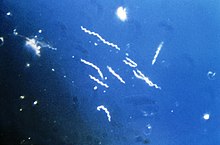Borrelia burgdorferi
| Borrelia burgdorferi | |
|---|---|
 |
|
| Borrelia burgdorferi | |
| Scientific classification | |
| Domain: | Bacteria |
| Phylum: | Spirochaetes |
| Order: | Spirochaetales |
| Family: | Spirochaetaceae |
| Genus: | Borrelia |
| Species: | B. burgdorferi |
| Binomial name | |
|
Borrelia burgdorferi Johnson et al. 1984 emend. Baranton et al. 1992 |
|
Borrelia burgdorferi is a bacterial species of the spirochete class of the genus Borrelia. B. burgdorferi exists in North America and Europe and is the predominant causative agent of Lyme disease in the United States. Borrelia species are considered diderm (double-membrane) bacteria rather than Gram-positive or negative.
Borrelia burgdorferi is named after the researcher Willy Burgdorfer, who first isolated the bacterium in 1982.
B. burgdorferi resembles other spirochetes in that it has an outer membrane and inner membrane with a thin layer of peptidoglycan in between. However, the outer membrane lacks lipopolysaccharide. Its shape is a flat wave. It is about 0.3 μm wide and 5 to 20 μm in length.
B. burgdorferi is an microaerobic, motile spirochete with seven to 11 bundled perisplasmic flagella set at each end that allow the bacterium to move in low- and high-viscosity media alike, which is related to its high virulence factor.
B. burgdorferi is a slow-growing microaerophilic spirochete with a doubling time of 24 to 48 hours. It is one of the few bacteria that can survive without iron, having replaced all of its iron-sulfur cluster enzymes with enzymes that use manganese, thus avoiding the problem many pathogenic bacteria face in acquiring iron.
B. burgdorferi circulates between Ixodes ticks and a vertebrate host in an enzootic cycle. B. burgdorferi living in a tick cannot be passed to its offspring. Therefore, tick larvae must feed on the blood of an infected animal to acquire B. burgdorferi, which ends up in the midgut. The spirochetes survive as the larvae molts into a nymph and persist in the nutrient-poor midgut as the nymph overwinters. Infected nymphs then transmit B. burgdorferi by feeding on another vertebrate to complete the cycle. Ticks can transmit B. burgdorferi to humans, but humans are dead-end hosts, unlikely to continue the life cycle of the spirochete. Nymphs molt into adult ticks, which usually feed on larger mammals that are not able to support the survival of B. burgdorferi.
...
Wikipedia
